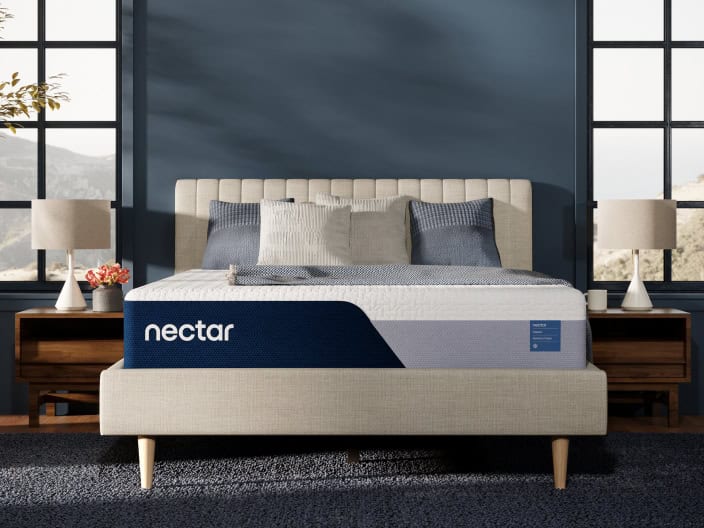11 Best Box Spring Alternatives
Share
Fact checked
Reviewed by experts
Updated
December 22, 2022
Quick read
5 mins to read
List of Content
Are you confused if you should buy a box spring for your brand new mattress? The simple answer to this is no; you need not buy a box spring for your bed. Many people report that box springs lead to back pains. So do you need a box spring? All you need is a foundation to support your mattress, and many box spring alternatives serve the purpose of a foundation. In our detailed guide, we will help you with the best box spring alternatives you can consider.
11 Box Spring Alternatives
You might be curious to know what to use instead of a box spring. Let’s learn about some handy box spring alternatives.
1. Under Mattress Slats
Under mattress slats are a great alternative to box springs. Under mattress slats are wooden/metal pieces spaced 3 inches apart to support your mattress. They are lighter than box springs. Box springs are a great option if you want to increase the lifespan of your mattress.
Pros
- Good to increase the lifespan of your mattress
- Easy to install
- Less costly
- Very thin and lightweight
Cons
- Can move during the night
- May lead some mattresses to sag
2. The Floor
It is effortless to use this box spring alternative. All you need to do is put the mattress on the floor. The flatness of the floor ensures that the mattress gets good support. Placing the bed on the floor also offers many health benefits, such as improved blood circulation, reduced back pain, and improved posture.
Pros
- Most affordable option
- An excellent option for hot sleepers
- Provides natural alignment of the spine
- Alleviates back pain
Cons
- Bad option for people with allergies
- May lead to back pain inside sleepers
- Mattress conditions may deteriorate due to dirt, dust mites, and microorganisms.
3. Milk Crate Bed Case
If you are looking for a decorative alternative to a box spring, this might be your best option. It is made by arranging milk crates. These are salvaging milk crates, and you can also decorate them using your art and craft skills. You can increase its firmness and longevity by using plywood.
Pros
- An excellent way to reuse milk crates
- Less expensive than box spring
- It improves the aesthetics of your bedroom
Cons
- Bad option for heavy sleepers
- It does not have springs
- It is not flexible enough
4. Platform Bed
Platform beds have a thick built-in foundation. You can use this bed frame without a box spring. They are made of wooden slats to provide circulation to the mattress. They are much better than a box spring and are available in three types: Solid, metal, and slat. Their height is lesser than a traditional box spring.
Pros
- Improves the look of your bedroom
- Available in different varieties
- Provide storage option
- Eliminates the need for bedding accessories
- Suitable for all types of mattresses
Cons
- Low height may be an issue for many people
- Much expensive than box springs
- Side sleepers may feel uncomfortable due to lower back pain.
5. Adjustable Bed
Adjustable beds have many hinges that allow you to set your body position according to your needs. Adjustable beds allow you to elevate your head at a particular angle if you face neck issues and raise your foot at an angle if you have lower back pain problems.
It is one of the best alternatives to box springs with loads of health benefits.
Pros
- It improves the sleep quality
- Flexible according to your sleeping needs
- Improves blood circulation
- Reduces the risk of acid reflux in people with GERD disease
Cons
- Very expensive compared to box spring
- You may need to buy compatible bedding accessories
- Even a small mechanical issue may put you into trouble
- Difficult to maintain
6. Memory Foam Mattress
What better than using a mattress that doesn’t require any foundation support. Memory foam mattresses are made from memory foam which is made from polyurethane and other chemicals. A memory foam mattress has an excellent ability to contour to the body shape of the sleeper. It is more supportive and responsive than a box spring. It is known to support joints and has excellent heat distribution properties. It distributes the bodyweight of the sleeper evenly. It is by far the best replacement for a box spring.
Pros
- It gives a cuddling feel to the sleeper
- Alleviates pressure in the joints
- Provides support to every body part
- No need for any extra bedding accessories
Cons
- Heavyweight
- May produce odor due to use of chemicals
- Continuous usage may lead to sagging
7. Hybrid Mattress
Hybrid mattresses are a combination of memory foam and innerspring mattresses. These mattresses are an excellent alternative to both box spring and memory foam mattresses. Hybrid mattresses consist of gelling agents that provide excellent breathability.
Pros
- An excellent option for people with back and joint pain
- Provides good air circulation
- Much firmer than memory foam mattresses
- Pressure point relief
Cons
- Much expensive than box springs
- Heavyweight
- May retain heat
8. Wood Slat Foundation
Wood slat foundation is made of a wooden box consisting of many wooden slats that provide a firm platform for the mattress. They are much cheaper compared to a box spring and are easy to replace.
Pros
- Much affordable compared to box spring
- Provide good storage space
- Improve air circulation
- Increases the lifespan of your mattress
- Easy to install and maintain
Cons
- Not ideal for heavy sleepers as it may break
- It tends to sag with time
9. Innerspring Mattress
Innerspring mattresses are another great alternative to box springs. It consists of a spring coils system in the underlying layers that provide features similar to a box spring.
Pros
- Have a longer lifespan
- Do not sag with extra body weight
- Improves airflow
Cons
- Not very flexible
- May lead to joint pain
- It becomes cranky and makes noise with time
10. Bunkie Boards
Bunkie boards are solid objects made from plywoods that fit between a mattress and a bed frame. They are 3 inches thick and can be used with existing bed frames such as metal frames and slatted foundations to increase firmness. They are lightweight and easy to shift. Bunkie board is thinner than a low-profile box spring.
Pros
- Extremely lightweight
- Prevents sagging of the mattress
- Lightweight and easy to relocate
- Cheaper than box springs
- Maximum support with an overhead clearance
Cons
- Extra height can be an issue with some sleepers
- Less breathability
11. DIY Box Spring Alternative
If the above box spring alternatives are not according to your preferences then the DIY box spring alternative is your best bet. You can start a creative DIY project. All you need is some handy skills and tools such as an electric drill, a staple gun, a counter stick, and wooden blocks.
Also, ensure that the project you are planning is able to handle your body weight.
Pros
- Most affordable option
- Create a bed base according to your preferred size
- No need to worry about skills, lots of online videos are available to assist you
Cons
- Some DIY projects take a lot of time to complete
- You may not get a proper finishing compared to a ready-made one
- Might be irritating if you are not a handy person and not into DIYs
What Is the Purpose of a Box Spring?
By now, you might have understood the various alternatives to a box spring. But it is essential to understand the exact purpose of the box spring and why do we use it?
Box springs serve many purposes that include-
- Providing extra support and firmness to the mattress
- Increasing the height of the mattress
- Acting as a shock absorbent and protecting the mattress
- Improving the airflow to keep the mattress cooler
Do You Really Need a Box Spring?
If you are planning to buy modern mattresses such as memory foam or latex mattresses, you do not need a box spring. Using a box spring may damage your mattress and decrease its lifespan. However, some mattress manufacturers may specify the use of foundation, which does not necessarily mean a box spring. You can use any box spring alternatives mentioned above that are compatible with your mattress and your sleeping preferences.
You can also create foundation support by yourself at home without spending any money on the expensive bed bases available in the market.
The Final Word
Box springs were a vital bedding accessory for many traditional mattresses including innerspring mattresses. However, today box springs are not necessary for many modern mattresses, such as memory foam and latex. Still, if you need extra support and firmness, you can opt for much more affordable and sleeker box spring alternatives ideas, as mentioned in the guide above.
Happy Sleeping!
FAQs
Yes, you can use a mattress without a box spring. Also, many mattresses such as memory foam and latex mattresses do not require a bed base of any kind. Instead, you can use box spring alternatives.
You can raise your bed using dedicated bed risers, inserting plywood between your mattress and bed frame, using a wedge, or attaching wheels to your bed frame.
No, you do not need a box spring for a memory foam mattress.
Modern mattresses such as memory foam and latex mattresses do not require a box spring.
You can dispose of your old box springs to a local dump or check for a pick-up facility from a local trash center, or you can also reuse some parts of your old box spring.
This website does not offer medical advice nor professional medical services; rather, it is provided solely for educational, informational, and/or entertainment purposes. Individuals seeking medical advice should consult a licensed physician. The information provided should not be used for diagnosis or treatment of any condition, disease, or injury. When you have a medical condition, you should always talk to licensed doctor or other certified medical professional. You should never delay seeking professional medical advice or treatment based on the contents of this website. Call 911 or immediately go to the nearest emergency room if you think you may have a medical emergency. The contents of this website are provided “as-is”, Sleep Authority and its parent, subsidiaries, affiliates, employees, contributors disclaim any warranty of the information contained herein. Please contact using contact form to report any errors, omissions, misinformation, or abuse.
Sleep Authority is brought to you by Resident, the company that brings you Nectar, DreamCloud, Awara, Wovenly, Bundle, Home Well Designed and Level Sleep.




